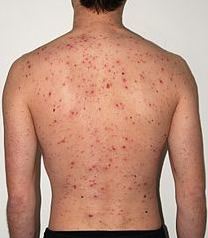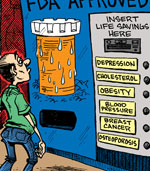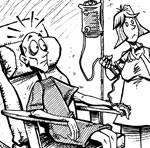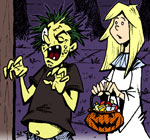Shingles - Frequently Asked Questions
| Share on Facebook | Share on Twitter | Share on Google+ |

Chickenpox Appears on Both Side of the Body
Photo by F. Malan
Q. Does shingles look like chickenpox?
A. Both condition cause tiny blisters on the skin, but chickenpox occurs all over the body, while shingles usually occurs only a small area of skin on one side of the body.
Q. Is a rash ever the first sign of shingles?
A. There are always other symptoms before the skin breaks out in blisters. The problem is that they can be so vague that you won't recognize what they are.
Q. Do women get internal shingles?
A. There are no cervical symptoms of shingles in women. Chances are that genital blisters in women would be due to genital herpes.
Q. What are the most common symptoms of shingles?
A. Nearly everyone will have both blisters and stabbing pain on the skin where the blisters break out. Unlike the pain caused by other skin conditions, shingles pain is relieved by rest.
Q. Are shingles related to allergies?
A. No, although it is possible to have both allergies and shingles, and it is not unusual at all to get a bacterial infection of the skin after the blisters break out.
Q. Can you give someone else shingles?
A. No, but you can give them chickenpox from your shingles if they have not had chickenpox before.
Q. Do you get shingles more than once?
A. About 1 in 20 people who get shingles have a second, usually milder episode.
Q. Can you get shingles if you never had chickenpox?
A. No, but it's possible to have such a mild case of chickenpox you didn't know you were sick, especially if you contract the virus after the age of 15.
Q. How long does the shingles rash last?
A. The shingles rash usually lasts a week to 10 days after the first appearance of blisters until the blisters dry up and scab over. It may take another week or 10 days for the scabs to fall off. Do not pick at them. This can leave you vulnerable to bacterial infection, and the scabs themselves can cause chicken pox in someone else.
Q. What are my chances of recovering completely from shingles?
A. Over 90% of people who get shingles have no lasting symptoms after about six weeks, and never get shingles again.
Q. My 67-year-old husband has shingles. Should I tell his 94-year-old mother she can't visit?
A. Your mother-in-law should not have direct contact with your husband's affected skin, just in case she did not have chickenpox as a child. She can't catch shingles, but she could catch chickenpox, which would probably be very serious at her age. As long as she does not have contact with the blisters, secretions, or scabs, however, there is no risk of infection, and if she has had chickenpox before, she will not get either chickenpox or shingles from your husband.
Q. Can you get shingles in the eye?
A. No, you can get shingles around the eye and even on the eyelid, but not in the eye itself. In especially severe cases, there might be a secondary bacterial infection of the eye, but that is preventable if you keep the eyes moist. People who take medications for irritable bladder or any medication that dries out the mouth or eyes should use sterile eye drops or liquid tears to keep the eyes moist so that bacteria cannot grow to levels that might cause a secondary infection.
Q. Can you have shingles without rash?
A. For most of the time you have a shingles outbreak, you don't have a rash. It is possible to have all the symptoms of shingles except the blistering rash, but this is most common in people under the age of 40.
-
Skin CareMen Skin Care
-
Free ResourcesFree eBooks
-
Every human being is the author of his own health or disease.Buddha
-
What We RecommendIf you do an analysis of the ingredients in a bottle of
 Total Balance and compare with other products you will find that it provides exceptional value for money…even against simple mass produced products with lower bottle costs.
Total Balance and compare with other products you will find that it provides exceptional value for money…even against simple mass produced products with lower bottle costs.
-



















